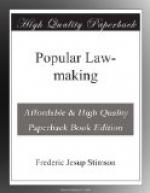In the same year—1100—is the Charter of “Liberties” of Henry I. It restores the laws of Edward the Confessor “with the amendments made by my father with the counsel of his barons.” It promises in the first section relief to the kingdom of England from all the evil customs whereby it had lately been oppressed, and finally returns to the people the laws of Edward the Confessor, “with such emendations as my father made with the consent of his barons."[1] In his charter to the citizens of London[2] he promises general freedom from feudal taxes and impositions, from dane-geld and from the fine for the murder of a Norman; and the Charter of Liberties issued by Henry II in 1154 confirms their “liberties and free customs to all men in the kingdom."[3] From this dates the equality of Englishmen before the law, commons as well as barons. Henry II was the first Norman king who had the old Saxon blood, and therefore he was looked forward to with a great deal of enthusiasm by the people of England. For although it is only one hundred years after the Conquest, the Normans and the Saxons had pretty well fused, and the Normans, who were inferior in number, had got thoroughly imbued with the free notion of Anglo-Saxon law. So they got this charter from him; but there is no legislation to concern us in it, it is only political. It has a great deal to do with the church, and with what the king will not do; it binds him, but it does not state any law directly.
[Footnote 1: Stubbs’s “Charters,” p. 101 (clause 13).]
[Footnote 2: Ibid., p. 108.]
[Footnote 3: Ibid., p. 135.]
There is further a continued evidence of the efforts of the people to restore the common law of England as against the king’s law or Roman law, or later against the law of the church, also a kind of Roman law known as canon law; and later still against the law of the king’s chancellor, what we should now call chancery jurisdiction; for the jealousy of chancery procedure was quite as great in the twelfth century as it is with the most radical labor leaders to-day; but of this later on.
In 1159 they succeeded in doing away with the Norman method of trying cases by battle and the Saxon method of trying by oath, and by the machinery of the Norman Great Assize introduced again trial by jury. For this in itself is probably an old Saxon institution. And in 1164 came the great Constitutions of Clarendon, the principal object of which was to free the people from the church law and subject the priests to the ordinary common law as in times before the Conquest—for now, “as the influence of the Italian lawyers increased,"[1] all the priests and clergy were above it. It was the first great statute which clearly subjected the church—which, of course, was the Church of Rome—to the common secular law. There was a vast jurisdiction of church law ("Doctors commons” courts lasted until a generation ago in England); some of it still remains.




